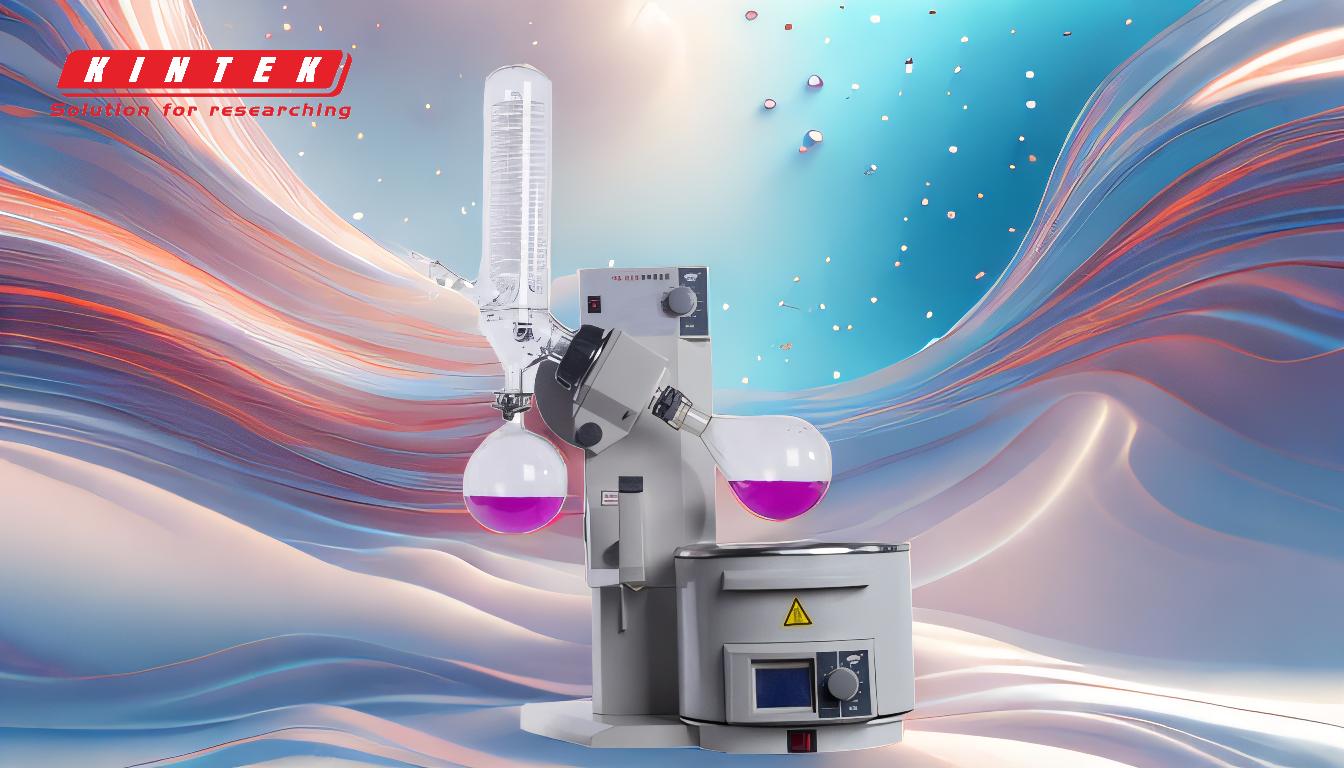A rotary evaporator rotates to enhance the efficiency and effectiveness of solvent removal through evaporation. The rotation mechanism creates a thin film of the sample on the inner wall of the flask, increasing the surface area for evaporation and ensuring uniform heating. This process reduces the risk of bumping and accelerates the distillation process, making it particularly beneficial for volatile and heat-sensitive materials. The rotation also ensures even mixing, preventing property alteration due to prolonged direct heat exposure. Overall, the rotation feature is crucial for achieving faster and more controlled evaporation, which is essential for various applications in laboratories and industries.
Key Points Explained:

-
Increased Surface Area for Evaporation:
- Explanation: The rotation of the flask in a rotary evaporator creates a thin film of the sample on the inner wall. This thin film significantly increases the surface area exposed to the heating source, which accelerates the evaporation process. The larger surface area allows for more efficient heat transfer and faster removal of solvents.
- Impact: This is particularly important in processes where time is a critical factor, such as in the concentration of non-volatile components or the extraction of volatile compounds.
-
Uniform Heating and Reduced Bumping:
- Explanation: The rotation ensures that the sample is evenly distributed across the inner surface of the flask, leading to uniform heating. This even distribution reduces the risk of "bumping," a phenomenon where sudden, violent boiling can cause the sample to splash out of the flask.
- Impact: Uniform heating and reduced bumping are crucial for maintaining the integrity of the sample and ensuring a smooth, controlled evaporation process.
-
Enhanced Mixing and Prevention of Property Alteration:
- Explanation: The rotation promotes even mixing of the sample, which is especially beneficial for volatile and heat-sensitive materials. This mixing prevents localized overheating and ensures that the sample is exposed to heat uniformly, thereby preventing any alteration of its properties.
- Impact: This is vital in applications where the chemical integrity of the sample must be preserved, such as in the pharmaceutical and food industries.
-
Centrifugal Force and Liquid Distribution:
- Explanation: The centrifugal force generated by the rotation keeps the liquid sample adhered to the inner wall of the flask. This force ensures that the liquid is spread out into a thin film, maximizing the surface area available for evaporation.
- Impact: The centrifugal force aids in maintaining a consistent and controlled evaporation process, which is essential for achieving precise results in laboratory and industrial settings.
-
Accelerated Distillation Process:
- Explanation: By increasing the surface area and ensuring uniform heating, the rotation mechanism significantly speeds up the distillation process. This acceleration is particularly beneficial when dealing with large volumes of solvents or when time-sensitive processes are involved.
- Impact: Faster distillation allows for more efficient use of time and resources, making the rotary evaporator an indispensable tool in various fields, including chemical, pharmaceutical, and food industries.
-
Versatility and Application in Various Industries:
- Explanation: The rotary evaporator's ability to efficiently remove solvents under reduced pressure makes it versatile and applicable in a wide range of industries. It is used for processes such as evaporation, concentration, crystallization, drying, separation, and solvent recovery.
- Impact: Its versatility makes it a common and essential piece of equipment in laboratories and industries, particularly in small-scale experiments and pilot production.
In summary, the rotation of a rotary evaporator is a critical feature that enhances the efficiency, control, and speed of the evaporation process. It ensures uniform heating, increases surface area, and prevents issues like bumping, making it an indispensable tool in various scientific and industrial applications.
Summary Table:
| Key Benefits of Rotary Evaporator Rotation | Explanation | Impact |
|---|---|---|
| Increased Surface Area for Evaporation | Creates a thin film for faster evaporation. | Speeds up solvent removal, ideal for time-sensitive processes. |
| Uniform Heating and Reduced Bumping | Ensures even heat distribution and prevents violent boiling. | Maintains sample integrity and smooth evaporation. |
| Enhanced Mixing and Property Preservation | Promotes even mixing to prevent localized overheating. | Preserves chemical integrity, crucial for sensitive materials. |
| Centrifugal Force for Liquid Distribution | Spreads liquid into a thin film for maximum evaporation. | Ensures consistent and controlled evaporation. |
| Accelerated Distillation Process | Increases surface area and ensures uniform heating. | Saves time and resources in large-scale or time-sensitive processes. |
| Versatility Across Industries | Efficiently removes solvents under reduced pressure. | Widely used in chemical, pharmaceutical, and food industries. |
Ready to optimize your lab processes with a rotary evaporator? Contact our experts today to find the perfect solution for your needs!










